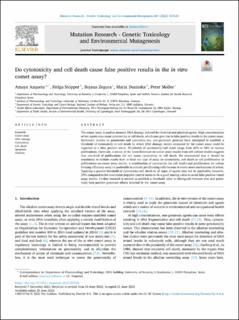| dc.contributor.author | Azqueta, Amaya | |
| dc.contributor.author | Stopper, Helga | |
| dc.contributor.author | Zegura, Bojana | |
| dc.contributor.author | Dusinska, Maria | |
| dc.contributor.author | Møller, Peter | |
| dc.date.accessioned | 2022-08-25T09:16:51Z | |
| dc.date.available | 2022-08-25T09:16:51Z | |
| dc.date.created | 2022-08-08T11:33:41Z | |
| dc.date.issued | 2022 | |
| dc.identifier.citation | Mutation Research. Genetic Toxicology and Environmental Mutagenesis. 2022, 881, 503520. | en_US |
| dc.identifier.issn | 1383-5718 | |
| dc.identifier.uri | https://hdl.handle.net/11250/3013487 | |
| dc.description.abstract | The comet assay is used to measure DNA damage induced by chemical and physical agents. High concentrations of test agents may cause cytotoxicity or cell death, which may give rise to false positive results in the comet assay. Systematic studies on genotoxins and cytotoxins (i.e. non-genotoxic poisons) have attempted to establish a threshold of cytotoxicity or cell death by which DNA damage results measured by the comet assay could be regarded as a false positive result. Thresholds of cytotoxicity/cell death range from 20% to 50% in various publications. Curiously, a survey of the latest literature on comet assay results from cell culture studies suggests that one-third of publications did not assess cytotoxicity or cell death. We recommend that it should be mandatory to include results from at least one type of assay on cytotoxicity, cell death or cell proliferation in publications on comet assay results. A combination of cytotoxicity (or cell death) and proliferation (or colony forming efficiency assay) is preferable in actively proliferating cells because it covers more mechanisms of action. Applying a general threshold of cytotoxicity/cell death to all types of agents may not be applicable; however, 25% compared to the concurrent negative control seems to be a good starting value to avoid false positive comet assay results. Further research is needed to establish a threshold value to distinguish between true and potentially false positive genotoxic effects detected by the comet assay. | en_US |
| dc.language.iso | eng | en_US |
| dc.rights | Navngivelse 4.0 Internasjonal | * |
| dc.rights.uri | http://creativecommons.org/licenses/by/4.0/deed.no | * |
| dc.title | Do cytotoxicity and cell death cause false positive results in the in vitro comet assay? | en_US |
| dc.title.alternative | Do cytotoxicity and cell death cause false positive results in the in vitro comet assay? | en_US |
| dc.type | Peer reviewed | en_US |
| dc.type | Journal article | en_US |
| dc.description.version | publishedVersion | en_US |
| dc.rights.holder | © 2022 The Authors. Published by Elsevier B.V. | en_US |
| dc.source.volume | 881 | en_US |
| dc.source.journal | Mutation Research. Genetic Toxicology and Environmental Mutagenesis | en_US |
| dc.identifier.doi | 10.1016/j.mrgentox.2022.503520 | |
| dc.identifier.cristin | 2041670 | |
| dc.relation.project | EC/H2020/814425 | en_US |
| dc.relation.project | EC/H2020/952404 | en_US |
| dc.relation.project | EC/H2020/857381 | en_US |
| dc.source.articlenumber | 503520 | en_US |
| cristin.ispublished | true | |
| cristin.fulltext | original | |
| cristin.qualitycode | 1 | |

